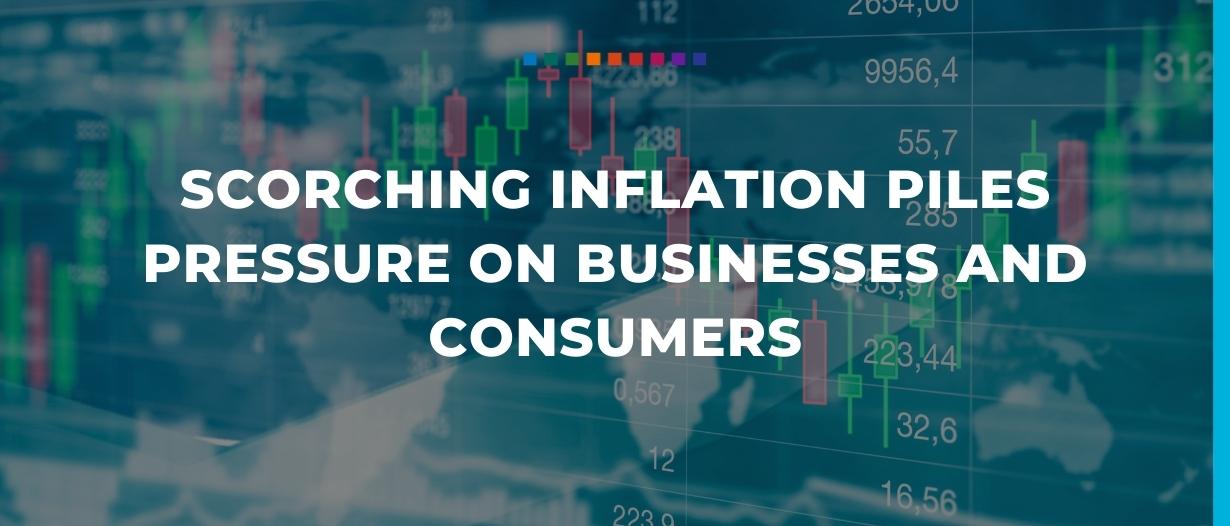Just as the UK was experiencing record temperatures and a summer heatwave, the annual rate of inflation accelerated to a fresh forty-year high.
Hot inflation has been making headlines for several months, and the cost of living crisis is front and centre for world leaders as they brace to protect their economies post-pandemic. But the reading from June represented a significant uptick toward double-figures and came just before a Bank of England (BoE) policy decision.
Rising inflation has been cited as a cause for major declines in economic activity and sentiment, driving consumer confidence to a record low. Joe Staton, client strategy director at GfK, said, “The impact of soaring food and fuel prices and rising interest rates continues to darken the financial mood of the nation.”
Plunging consumer confidence has translated to deep declines in retail sales for the past three months, dropping year-over-year by 5.8%, 4.7%, and 5.8% for April, May, and June respectively.
Businesses haven’t escaped either, with the Confederation of British Industry publishing its quarterly measure of manufacturing optimism in July slightly up from April, but still in deeply negative territory.
Meanwhile, the monthly Purchasing Managers Index reports from S&P Global/CIPS show a worrying picture for the services and manufacturing sectors–in part due to intense wage pressures and high input costs.
What is inflation?
Inflation is the sustained rise in the average price of goods and services. It’s typically described as a year-over-year percentage change, and the standard international measure is the Consumer Price Index (CPI).
Whilst markets and the media focus on the headline CPI reading, many central banks and governments have their own favoured gauge of inflation:
- The US Federal Reserve prefers Personal Consumption Expenditure (PCE).
- The BoE is set a target for CPI by the Treasury, but the Office for National Statistics uses CPIH–the added ‘H’ referring to housing costs–as its preferred gauge.
- The European Central Bank uses the Harmonised Index of Consumer Prices (HICP) to measure consumer price inflation uniformly across all EU countries.
How hot is UK inflation compared to other countries?
The United Kingdom currently has the sixth highest rate of inflation in the G20, behind Turkey, Argentina, Russia, Brazil, and Spain.
With volatile food and energy prices deducted from the CPI figure, ‘core inflation’ is marginally lower in the UK than in the U.S. and Canada.
The United States is also gripped by inflation, likewise Canada and Europe (as a whole).
The story is different for Japan, which has experienced low inflation and at times deflation, caused by anaemic growth and reluctance to raise prices or wages.
Switzerland has seen similar trends, with partial protection from a strong franc, a mix of energy supply that is less exposed to energy price volatility, and controls on wages.
What’s clear is that inflation is a global issue. Governments around the world fed enormous amounts of money into the economy to prevent a collapse–a major contributing factor to the inflation we are seeing today.
Additionally, the well-documented supply chain issues during the pandemic period stunted capacity.
Demand grew as locked-down consumers bought goods for delivery without anything else to spend their cash–and stimulus cheques–on.
Brexit-related supply issues have likely contributed to an elevated inflationary picture in the UK, and of course, rising energy and food prices, spurred on by the Russia-Ukraine conflict, is a great push on prices.
The Bank of England and the pound
Central banks can use their monetary policy tools to reduce demand in the economy, slow down growth, and reduce inflation.
The BoE was one of the first major central banks to raise interest rates in this current cycle of policy tightening.
In December 2021, after months of signalling hikes on the way and deliberation over whether inflation was ‘transitory’, Governor Andrew Bailey announced the lift from 0.1% to 0.25%. Since then, the BoE has hiked rates by 25 basis points for a further four consecutive meetings, taking the Bank Rate to 1.25%.
However, some commentators believe the BoE is behind the curve in battling inflation, pointing to other central banks that have been more proactive, including the US Fed and the Bank of Canada.
Governor Bailey has been quite clear in explaining a desire to control inflation without triggering a recession or widespread economic harm, hitting the vulnerable the hardest.
The UK is a consumer-led economy.
A recent poll by YouGov (https://www.bloomberg.com/news/articles/2022-06-20/uk-consumers-most-worried-in-major-economies-about-inflation) showed that Brits are the gloomiest about future prospects for the cost of living.
Clearly, the BoE’s unfavourable forecasts for future inflation and growth are providing the necessary ‘nudge’ to invoke changes in consumer behaviour–precisely what is required to quell inflation.
BoE policymaker, Catherine Mann has raised concerns about the weakness of the pound contributing to inflation (https://www.reuters.com/world/uk/bank-englands-mann-says-weak-pound-makes-case-big-rate-hike-2022-06-20/): the UK is a net importer, and energy is priced in dollars, so inflation is compounded by weakness in sterling.
The pound is down over 10% against the US dollar since the turn of the year and is one of the poorest performing currencies among G10 FX peers.
The cocktail of pressures weighing on the pound includes; a stronger dollar thanks to safe-haven demand and the Fed’s aggressive rate hikes, a gloomy domestic economic picture, political turmoil, and the consequences and administration of Brexit.
It will take a lot for currency traders to flip their persistently short bets on the pound and lift the price back toward $1.30.
























